Scientific name: Lavandula angustifolia
Common name: English Lavender
Plant Family: Mint (Lamiaceae)
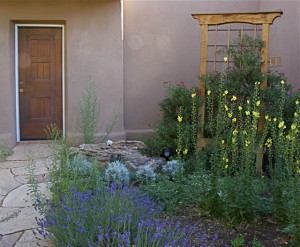
Lavender and wildflower garden (Janice Tucker)
Article by Jeanne Gozigian
“Lavender’s blue, dilly, dilly, lavender’s green…”, so goes the song and nursery rhyme, which originated in a bawdy, 17th century English folk song, called “Diddle Diddle! This much beloved favorite of Santa Fe gardeners indeed has flowers ranging from deep purple to light blue, with silver green leaves. Because of its lovely, distinctive fragrance, which lends itself so beautifully to soaps, oils, perfumes, lotions, and such luxuries for the bath, it has been speculated that the name comes from the Old French – lavandre – to wash, or the Latin –lavare. To wash, in modern French, is laver. But, another Latin word – livere – mean’s “bluish”, so one could logically accept either derivation. In fact, the deeper blue the color of the blossoms, the more aromatic the essential oil for perfumery or culinary purposes.
There are 39 species of Lavandula, which are part of the Mint (Lamiaceae) Family and, characteristically, have strong aromas, some more than others. Like all mints, they have square stems. Many believe that English Lavender (L. angustifolia) has the strongest perfume of all the angustifolia cultivars. Lavandula are native to the Old World from Southern Europe through Africa and to the Far East but now can be found throughout the world. The whorls of flowers occur on spikes, have 5 petals and tubular calyxes, and are often asymmetrical.
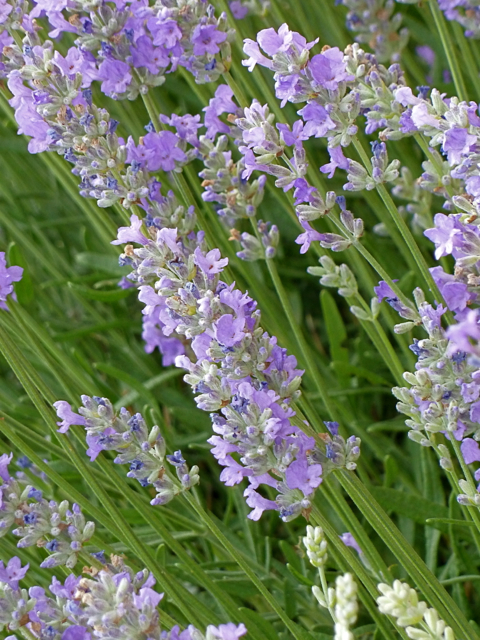
Lavender species close up (Janice Tucker)
Because L. angustifolia is cold hardy, does not like high humidity, and thrives in the marginal soil that is typical to our area, it can be very happy in Santa Fe gardens. Plant the shrubs in full sun with few or no soil amendments, making sure
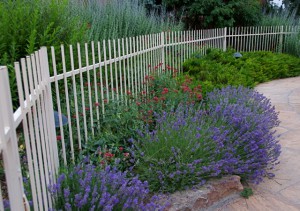
Lavender border (Janice Tucker)
that the soil is well drained; Lavender hates wet feet. Likewise, organic mulches hold too much moisture; use gravel or fine granite mulch around the plants. When the new plants are established, they only need watering once or twice a month, keeping rainfall and temperatures in mind. Cut back the plants by half in early spring to encourage new growth. Deadheading also encourages further blooming.
The more common European lavenders are the Spanish (L. stoechas) and French (L. dentata). Both need higher humidity than Santa Fe can provide so they typically would be grown as houseplants or in protected areas. They could make good container plants in sunny courtyards with protection from drying winds. They are capable of escaping garden areas and thriving in the wild. L. stoechas is listed as an invasive, noxious weed in Australia! Walking from town to town in the French countryside, the scent of lavender is often detected on the breeze. This is probably due to the fact that L. dentata is the most fragrant of all of the Lavandula species. It would be romantic to believe that the herb mixtures, Herbes de Provence (France), and Herbes de Maquis (Corsican shrubland), both containing lavender among other herbs, were created by gathering these feral natives. The reality is that these tasty herbal blends were invented by culinary experts in the 1970’s. However, both make wonderful additions to salad dressings, soups, and stews.
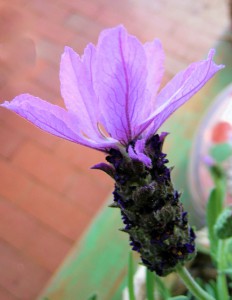
Lavender stoechas (Janice Tucker).
As a culinary herb, lavender adds exquisite notes to many foods and condiments. A French B&B in Provence served a lovely preserve made from lavender buds when an American hiking group stayed there. Lavender provides its unique taste to ices and ice cream for a summertime treat. Lavender lemonade is a refreshing beverage. Candied blossoms make beautiful decorations atop jewel-like petits fours, while fresh blossoms are pretty in a green salad. Bees drinking lavender nectar produce delightful lavender honey.
Dried lavender, used in sachets, gives a refreshing scent to linens and clothes. It is believed that lavender can deter moths and other insects. Swooning Victorian women swore by lavender water to bathe their fevered brows. The dried blossoms retain their color and fragrance for very long periods of time so are ideal for dried arrangements and potpourri mixtures. Alternative Medicine adherents believe that lavender oil has antiseptic and anti-inflammatory properties.
One might ask, “What is not to love about lavenders in Santa Fe gardens”? The Santa Fe Botanical Garden at Museum Hill has the cultivars Hidcote, Munstead, Sharon Roberts, Grosso, and Provence. The Garden will be keeping meticulous records on mortality of plants in the collection. Lavenders exist as annuals and perennials, but there is no guarantee that perennials will last forever. It appears to be crucial that winter watering is done, and that spring, or fall cut back is accomplished. Check with your favorite nursery or garden expert for advice on which plants to add to your garden. And be prepared to replant if you lose some; it seems that our occasional extremely cold and increasingly dry winters may add to plant loss. But, if you do not already have these aromatic beauties in your garden, why not give them a try? The bonus of their blue beauty and fantastic perfume should be well worth the effort.
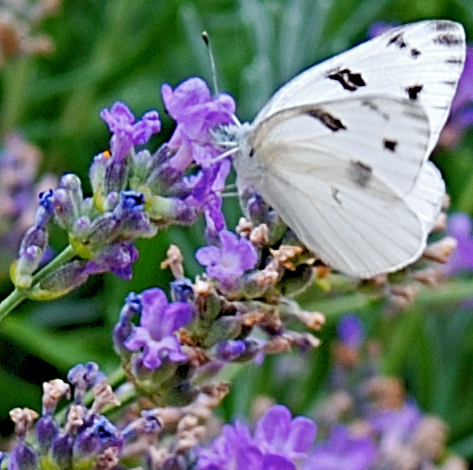
Butterfly on lavender (Janice Tucker).


